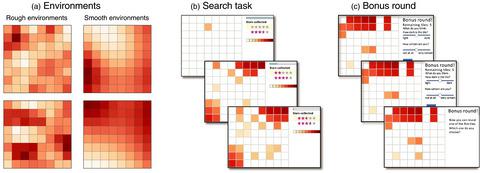Our official English website, www.x-mol.net, welcomes your
feedback! (Note: you will need to create a separate account there.)
Development of directed and random exploration in children
Developmental Science ( IF 3.1 ) Pub Date : 2021-02-04 , DOI: 10.1111/desc.13095 Björn Meder 1 , Charley M Wu 2 , Eric Schulz 3 , Azzurra Ruggeri 4
Developmental Science ( IF 3.1 ) Pub Date : 2021-02-04 , DOI: 10.1111/desc.13095 Björn Meder 1 , Charley M Wu 2 , Eric Schulz 3 , Azzurra Ruggeri 4
Affiliation

|
Are young children just random explorers who learn serendipitously? Or are even young children guided by uncertainty-directed sampling, seeking to explore in a systematic fashion? We study how children between the ages of 4 and 9 search in an explore–exploit task with spatially correlated rewards, where exhaustive exploration is infeasible and not all options can be experienced. By combining behavioral data with a computational model that decomposes search into similarity-based generalization, uncertainty-directed exploration, and random exploration, we map out developmental trajectories of generalization and exploration. The behavioral data show strong developmental differences in children's capability to exploit environmental structure, with performance and adaptiveness of sampling decisions increasing with age. Through model-based analyses, we disentangle different forms of exploration, finding signature of both uncertainty-directed and random exploration. The amount of random exploration strongly decreases as children get older, supporting the notion of a developmental “cooling off” process that modulates the randomness in sampling. However, even at the youngest age range, children do not solely rely on random exploration. Even as random exploration begins to taper off, children are actively seeking out options with high uncertainty in a goal-directed fashion, and using inductive inferences to generalize their experience to novel options. Our findings provide critical insights into the behavioral and computational principles underlying the developmental trajectory of learning and exploration.
中文翻译:

儿童定向和随机探索的发展
年幼的孩子只是偶然学习的随机探索者吗?或者甚至是幼儿在不确定性导向抽样的指导下,寻求以系统的方式探索?我们研究了 4 到 9 岁的儿童如何在具有空间相关奖励的探索-利用任务中进行搜索,其中详尽的探索是不可行的,并且并非所有选项都可以体验。通过将行为数据与将搜索分解为基于相似性的泛化、不确定性导向的探索和随机探索的计算模型相结合,我们绘制出泛化和探索的发展轨迹。行为数据显示,儿童利用环境结构的能力存在很大的发展差异,抽样决策的表现和适应性随着年龄的增长而增加。通过基于模型的分析,我们解开了不同形式的探索,找到了不确定性导向和随机探索的特征。随着儿童年龄的增长,随机探索的数量会大大减少,这支持了调节抽样随机性的发育“冷静”过程的概念。然而,即使在最小的年龄范围内,孩子们也不仅仅依赖于随机探索。即使随机探索开始逐渐减少,孩子们也在以目标导向的方式积极寻找具有高度不确定性的选项,并使用归纳推理将他们的经验推广到新的选项。我们的研究结果为学习和探索的发展轨迹背后的行为和计算原理提供了重要的见解。寻找不确定性导向和随机探索的特征。随着儿童年龄的增长,随机探索的数量会大大减少,这支持了调节抽样随机性的发育“冷静”过程的概念。然而,即使在最小的年龄范围内,孩子们也不仅仅依赖于随机探索。即使随机探索开始逐渐减少,孩子们也在以目标导向的方式积极寻找具有高度不确定性的选项,并使用归纳推理将他们的经验推广到新的选项。我们的研究结果为学习和探索的发展轨迹背后的行为和计算原理提供了重要的见解。寻找不确定性导向和随机探索的特征。随着儿童年龄的增长,随机探索的数量会大大减少,这支持了调节抽样随机性的发育“冷静”过程的概念。然而,即使在最小的年龄范围内,孩子们也不仅仅依赖于随机探索。即使随机探索开始逐渐减少,孩子们也在以目标导向的方式积极寻找具有高度不确定性的选项,并使用归纳推理将他们的经验推广到新的选项。我们的研究结果为学习和探索的发展轨迹背后的行为和计算原理提供了重要的见解。支持调节抽样随机性的发展性“冷却”过程的概念。然而,即使在最小的年龄范围内,孩子们也不仅仅依赖于随机探索。即使随机探索开始逐渐减少,孩子们也在以目标导向的方式积极寻找具有高度不确定性的选项,并使用归纳推理将他们的经验推广到新的选项。我们的研究结果为学习和探索的发展轨迹背后的行为和计算原理提供了重要的见解。支持调节抽样随机性的发展性“冷却”过程的概念。然而,即使在最小的年龄范围内,孩子们也不仅仅依赖于随机探索。即使随机探索开始逐渐减少,孩子们也在以目标导向的方式积极寻找具有高度不确定性的选项,并使用归纳推理将他们的经验推广到新的选项。我们的研究结果为学习和探索的发展轨迹背后的行为和计算原理提供了重要的见解。孩子们正在以目标导向的方式积极寻找具有高度不确定性的选项,并使用归纳推理将他们的经验推广到新的选项。我们的研究结果为学习和探索的发展轨迹背后的行为和计算原理提供了重要的见解。孩子们正在以目标导向的方式积极寻找具有高度不确定性的选项,并使用归纳推理将他们的经验推广到新的选项。我们的研究结果为学习和探索的发展轨迹背后的行为和计算原理提供了重要的见解。
更新日期:2021-02-04
中文翻译:

儿童定向和随机探索的发展
年幼的孩子只是偶然学习的随机探索者吗?或者甚至是幼儿在不确定性导向抽样的指导下,寻求以系统的方式探索?我们研究了 4 到 9 岁的儿童如何在具有空间相关奖励的探索-利用任务中进行搜索,其中详尽的探索是不可行的,并且并非所有选项都可以体验。通过将行为数据与将搜索分解为基于相似性的泛化、不确定性导向的探索和随机探索的计算模型相结合,我们绘制出泛化和探索的发展轨迹。行为数据显示,儿童利用环境结构的能力存在很大的发展差异,抽样决策的表现和适应性随着年龄的增长而增加。通过基于模型的分析,我们解开了不同形式的探索,找到了不确定性导向和随机探索的特征。随着儿童年龄的增长,随机探索的数量会大大减少,这支持了调节抽样随机性的发育“冷静”过程的概念。然而,即使在最小的年龄范围内,孩子们也不仅仅依赖于随机探索。即使随机探索开始逐渐减少,孩子们也在以目标导向的方式积极寻找具有高度不确定性的选项,并使用归纳推理将他们的经验推广到新的选项。我们的研究结果为学习和探索的发展轨迹背后的行为和计算原理提供了重要的见解。寻找不确定性导向和随机探索的特征。随着儿童年龄的增长,随机探索的数量会大大减少,这支持了调节抽样随机性的发育“冷静”过程的概念。然而,即使在最小的年龄范围内,孩子们也不仅仅依赖于随机探索。即使随机探索开始逐渐减少,孩子们也在以目标导向的方式积极寻找具有高度不确定性的选项,并使用归纳推理将他们的经验推广到新的选项。我们的研究结果为学习和探索的发展轨迹背后的行为和计算原理提供了重要的见解。寻找不确定性导向和随机探索的特征。随着儿童年龄的增长,随机探索的数量会大大减少,这支持了调节抽样随机性的发育“冷静”过程的概念。然而,即使在最小的年龄范围内,孩子们也不仅仅依赖于随机探索。即使随机探索开始逐渐减少,孩子们也在以目标导向的方式积极寻找具有高度不确定性的选项,并使用归纳推理将他们的经验推广到新的选项。我们的研究结果为学习和探索的发展轨迹背后的行为和计算原理提供了重要的见解。支持调节抽样随机性的发展性“冷却”过程的概念。然而,即使在最小的年龄范围内,孩子们也不仅仅依赖于随机探索。即使随机探索开始逐渐减少,孩子们也在以目标导向的方式积极寻找具有高度不确定性的选项,并使用归纳推理将他们的经验推广到新的选项。我们的研究结果为学习和探索的发展轨迹背后的行为和计算原理提供了重要的见解。支持调节抽样随机性的发展性“冷却”过程的概念。然而,即使在最小的年龄范围内,孩子们也不仅仅依赖于随机探索。即使随机探索开始逐渐减少,孩子们也在以目标导向的方式积极寻找具有高度不确定性的选项,并使用归纳推理将他们的经验推广到新的选项。我们的研究结果为学习和探索的发展轨迹背后的行为和计算原理提供了重要的见解。孩子们正在以目标导向的方式积极寻找具有高度不确定性的选项,并使用归纳推理将他们的经验推广到新的选项。我们的研究结果为学习和探索的发展轨迹背后的行为和计算原理提供了重要的见解。孩子们正在以目标导向的方式积极寻找具有高度不确定性的选项,并使用归纳推理将他们的经验推广到新的选项。我们的研究结果为学习和探索的发展轨迹背后的行为和计算原理提供了重要的见解。









































 京公网安备 11010802027423号
京公网安备 11010802027423号